#wetland arthropods
Text


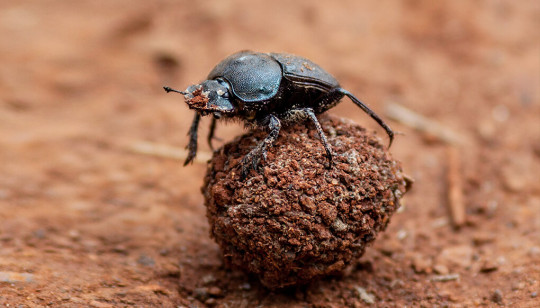
Roll Up with the Sacred Scarab
The sacred scarab (Scarabaeus sacer) is perhaps the most famous of all dung beetles as a symbol of worship by ancient Egyptians. Outside its godly role, this species can be found throughout northern Africa, as well as southern Europe and into western Asia as far as India. In Africa it inhabits both deserts and scrubland, as well as agricultural areas where food is abundant, while in Europe the sacred scarab stays more towards the coast in dunes and marshes.
Aside from its well-known association with religion, the sacred scarab is known best for its association with dung. When a source has been found, individuals roll it into tightly compressed balls known as telecoprids, which can weigh up to ten times their size. These telecoprids are then rolled with the hind legs to an underground chamber where S. sacer strains out and feeds on nutrient-rich fluids, molds, and undigested particles from the ball over several days. In addition to its role as a nutrient recycler, the sacred scarab is also an important source of food for many small mammals, reptiles, and birds.
In its native range, the sacred scarab will mate year-round provided food is abdunant. Males and females work together to form and move a dung ball back to the underground nest; it is during this stage that males will fight each other for control of the ball, while the female will simply follow wherever the telecoprid goes. Once in the next, male and female briefly copulate before the male departs to search for another mate. The female then sculpts the dung ball into a pear shape and lays a single egg in the narrower end, which is then sealed. Her job done, she too leaves to seek out another partner and repeat the process, laying over a dozen eggs in her lifetime.
After a week or two, a single larva emerges from the egg and begins feeding on the dung around it. Over the next 3 months, it will molt up to three times before forming a pupa. About a month later, a fully mature adult emerges and burrows its way to the surface to find a fresh source of food and potential mates. Unlike many beetle species, the sacred scarab is an adept flyer, and will often use its wings to travel between food sources as opposed to walking.
Though the sacred scarab may seem ornate in Egyptian hieroglyphics and jewelry, the species itself is quite plain. Individuals are completely black, and both sexes are indistinguishable from each other. Individuals can range from 1.9 to 4.0 cm (0.7 to 1.6 in) long, and weigh up to 2 g (0.07 oz). One interesting feature is their front feet; unlike other dung beetles, S. sacer doesn't have any. Instead they only have a vestigial claw-like structure that can be used for digging.
Conservation status: This species has not been evaluated by the IUCN, but due to its large population size and adaptability to urban and agricultural expanstion it is considered relatively stable.
If you like what I do, consider leaving a tip or buying me a ko-fi!
Photos
Amadej Trnkoczy
Kev Gregory
San Diego Zoo
#sacred scarab#Coleoptera#Scarabaeidae#scarab beetles#beetles#insects#arthropods#deserts#desert arthropods#scrubland#scrubland arthropods#wetlands#wetland arthropods#urban fauna#urban arthropods#africa#north africa#europe#southern europe#middle east#asia#west asia#animal facts#biology#zoology
132 notes
·
View notes
Text
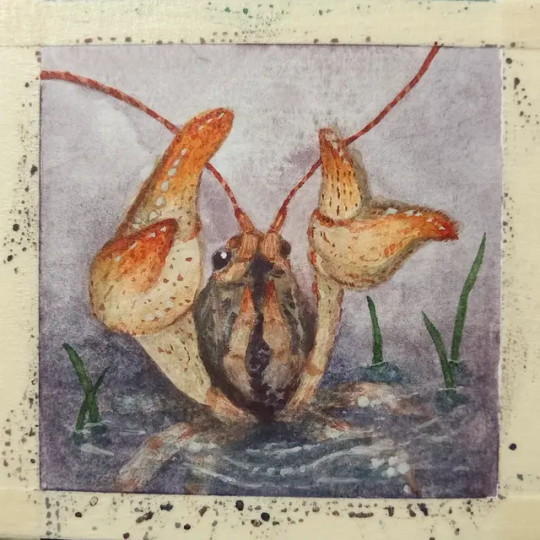
Startle 🦞
but it wasn't a rock...
#world#watercolor#month#group#art#illustration#painting#artist#wildlife#animal#wetlands#nature#crayfish#crawdad#crawfish#mudbug#crustacean#arthropod#artist on tumblr#blynx art
101 notes
·
View notes
Text

Arthropoid... Hydrogen based lifeform? ISBN 10: 0521783674 Wetland Ecology: Principles and Conservation
1 note
·
View note
Text

March 29, 2024 - Sharp-billed Canastero or Lesser Canastero (Asthenes pyrrholeuca)
These birds in the ovenbird family are found in shrublands, grasslands, wetlands, and other open habitats. Breeding in southern Argentina and Chile, part of their population migrates as far north as Uruguay, Paraguay, and Bolivia for the winter. They eat arthropods, foraging alone or in pairs mostly in low vegetation and often joining mixed-species flocks. Their round nests with side or top entrances are built in bushes or on the ground from small twigs and lined with soft plant material, hair, and feathers. Females lay clutches of two to four eggs.
#sharp-billed canastero#canastero#ovenbird#asthenes pyrrholeuca#bird#birds#illustration#art#grassland#birblr art
55 notes
·
View notes
Text
These are some of my favorite, less well known, non-malacostracan crustaceans!
Mystacocarids
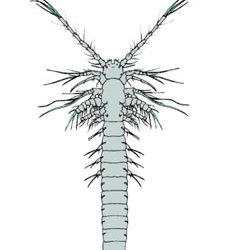
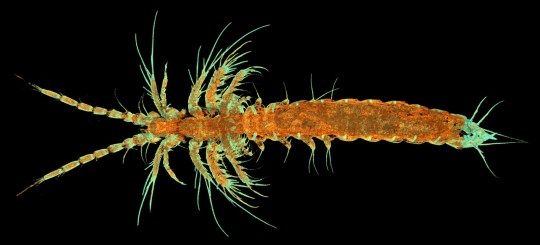
They are usually placed in a group with Ostracods, that is basal to all other extant crustaceans, meaning crabs, barnacles, and bees are all more closely related to each other than they are too Mystacocarids. They live in between grains of sand on beaches in many parts of the world. They get up to 1 millimeter long. I like how they kinda look like feather dusters, or like stretched out lice with too many legs.
Cephalocarids or Horseshoe shrimp
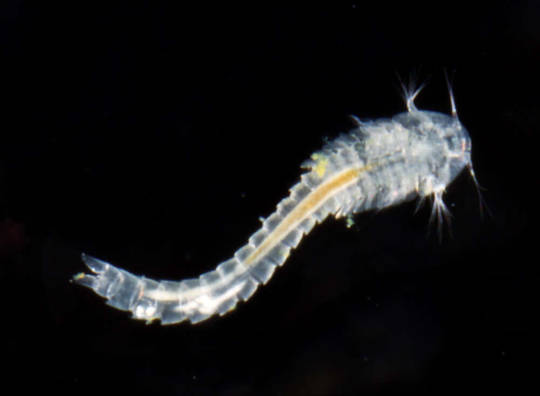
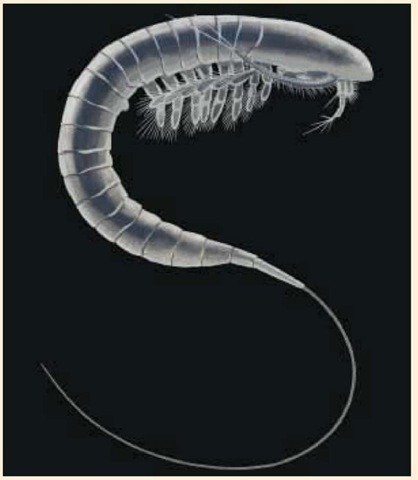
These guys were only discovered in the 1950s century and since then have been grouped with the remipedes, although recently they typically are instead placed in their own group! They are benthic organisms that live in all kinds of sediment from the shore to the deep sea, and typically eat detritus. They are hermaphroditic, have no eyes , and get up to 4 mm long! I think they look a lot like some primitive, Cambrian era arthropods, and despite being small and probably not likely to fossilize, their fossil record extends back to Ordovician, so the appellation of them being "Cambrian survivors" may very well be accurate.
Notostracans or Tadpole Shrimp


Consisting of the genera Triops and Lepidurus, this group of animals is most closely related to water fleas and clam shrimp , and more distantly to fairy shrimp (such as the famous sea monkey brine shrimp). Like brine shrimp, Triops are a common pet. Both genera are known to have populations in temporary pools of water, and have long lasting eggs that can survive desiccation and years without water before hatching again when the water returns. They also can live in shallow lakes, certain wetlands, and other more permanent ponds, and depending on species live in fresh, brackish or even salt lakes, but don't live in marine environments. They are omnivores and will basically eat anything, including smaller members of their own species. For a relatively small group of crustaceans, they have a wide variety of reproductive strategies, with some populations having sexually reproducing males and females, some having exclusively self fertilizing females, others being primarily hermaphroditic, and still others being different mixes of these. This variation is present even in different populations of the same species. They can get up to about 7 cm long , making them much larger than the previously mentioned crustaceans, but not big enough! They are so cute I wish they were big enough I could give them hugs. I think they should be the size of cats .
Remipedes


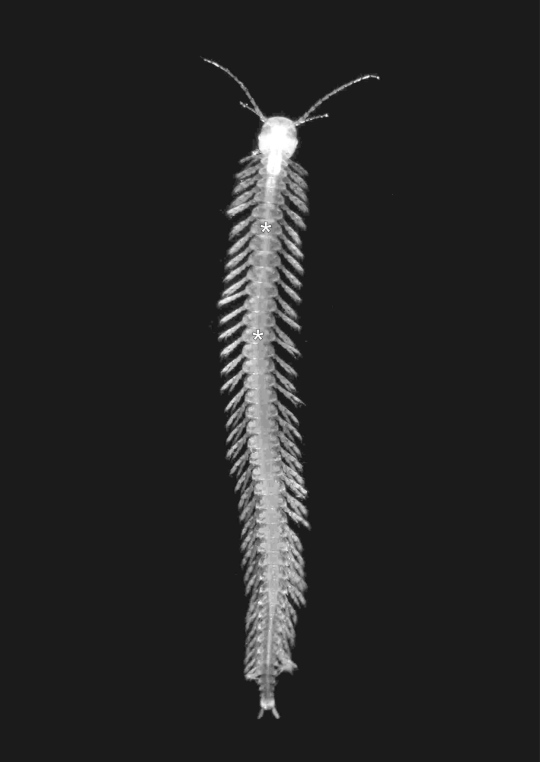
Remipedes are really special, the first living remipedes were only discovered in the late 1970s, and weren't properly described until 1981, meaning our knowledge of living remipedes is only as old as goth music. To be honest their lifestyle is pretty goth too, they exclusively live in caves and aquifers, typically in subtropical , coastal regions. As befitting creatures of the dark, they have no eyes or pigmentation, and instead have an advanced sense of smell. While they are also capable of filter feeding, they have venomous fangs that they use to predate on smaller organisms, and indeed are the only venomous crustaceans (outside of insects). Unlike the predatory adults, remipede larva don't seem to eat at all, and it's speculated that they may instead derive nutrition from symbiotic bacteria. Remipedes have 32 segments, and being hermaphroditic, have female and male openings on different segments of their bodies (7 and 14, respectively) . Despite their seemingly primitive bodies and strange lifestyle, remipedes have actually been discovered to be the group of crustaceans that are closest to the Hexapods, including the insects! They get up 4 cm long but I wish they were as long as eels.
I also kinda wanted to write about clam shrimp here but their phylogeny is a bit of a mess right now and I'm not even sure what qualifies as a clam shrimp anymore. They basically look like little clam shells with a crustacean swimming around in them.
15 notes
·
View notes
Photo

Amazonian Royal Flycatcher (Onychorhynchus coronatus)
Family: Sharpbill Family (Oxyruncidae)
IUCN Conservation Status: Least Concern
Found in wetlands and rainforests surrounding the Amazon basin of South America, the Amazonian Royal Flycatcher is best known for the striking collapsible crest of orange and black feathers seen on the heads of males, such as the individual pictured above. When not in use, the crest folds up in a manner similar to a paper fan and lies against the back of the head and neck. Male Amazonian Royal Flycatchers primarily use their crests when attempting to court females, but it has been suggested that they may also use them to appear larger in an effort to ward off predators when they feel threatened (notably, males almost always erect their crest when being handled by humans, supporting the theory that this is a defensive behaviour.) This species feeds on small arthropods such as flies, cicadas, dragonflies, butterflies, grasshoppers and ticks, and nests in thin, narrow nests which it suspends dangling from branches and often constructs above water, possibly to make them harder for predators and egg-thieves to reach. After mating, female Amazonian Royal Flycatchers lay a clutch of around 2 eggs which they incubate without the assistance of males.
-----------------------------------------------------------------------------
Image Source: https://www.inaturalist.org/observations/71898563
#amazonian royal flycatcher#flycatcher#royal flycatcher#royal flycatchers#bird#birds#zoology#biology#Ornithology#animal#animals#wildlife#south american wildlife
123 notes
·
View notes
Text

OKAY hear me out.
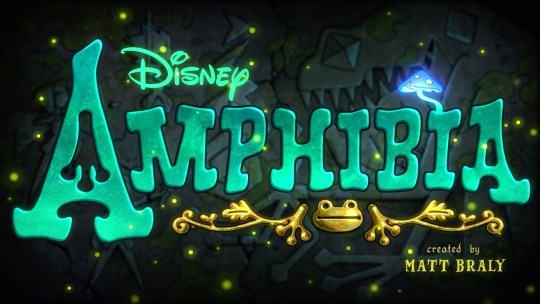
Morrowind is so similar to Amphibia. I love the fantasy elements of both worlds.
Amphibia is a place where 90% of the wildlife outside of the cities, kingdom, and towns is trying to murder you. Same as Morrowind! They both also have a lot of reptilian creatures, amphibians, and arthropods that bode well together.
I adored looking at the backgrounds of the show and the game. There were so many swamp, forest, and wetland aesthetics mixed with the mystery behind both mediums.
SPOILERS BELOW POST
They both even have a prophecy where the Main Character(s) will need to face a world-ending force.
I could go on all day about the differences. I mean, Morrowind has the Player Character dealing with divine diseased ash creatures and a chad god living in his Red Mountain lava jacuzzi.
In comparison to that, Amphibia is dealing with a cyborg newt king that wants to take over both worlds while three of the Main Characters got isekai'd into the world.
Idk if it's a bit of a stretch to compare them, but I love both dearly. <3
11 notes
·
View notes
Note
What types of bugs are used for what purposes? Are some ridden like horses (so transportation) while others are used for resources and some for pets? How is that determined?
Absolutely adore the idea of having a giant flightless beetle friend (specifically my fav, the japanese beetle), such amazing ideas and art!!
Oh, you have No idea what a question you have just asked... (cracks knuckles) Here we go...
Insects are incredibly wide-spread, but not often the domestication process is as successful. The domestication is often only possible with non-predator species, and to have enough generations to alter and selectively breed preferable traits.
But, the process of domestication of various species for different purposes has been implemented in many places across Terra Sonalis, the most common ones are described here:

Thanks to some cities being entirely constructed on trees or tree-tops, having familiars that help to transport both the rider and carry 'luggage' up and down safely has been a very important development. But, they do indeed have their limits, mostly when it comes to distance that isn't as vertical. Don't get me wrong, they will definitely save time travelling on land, but due to the high metabolism which requires frequent nectar breaks, it's more efficient to travel up or down a familiar, safe, blooming tree than across a forest with unexpected surprises and/or predators. For security measures, the people have chosen to prioritize moths with more bright and vivid colors, to mimic more unpleasant species to interact with for increased safety.
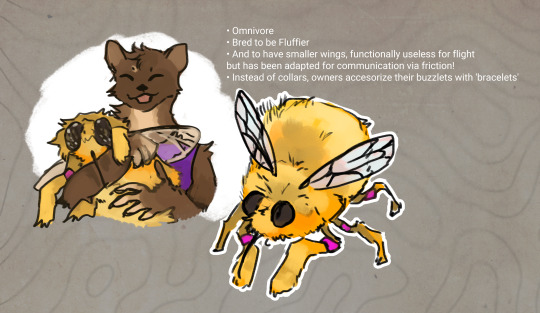
A relatively small critter, resembling a bee fly - Do I really need to explain why they made such good pets and companions? They've been bred to be fluffier and reduce in their wing span, they're bad at flights nowadays, but still use those for communication via friction. And, as omnivores, they're great at cleaning up leftovers.

Communities of river-valleys and wetlands have cultivated breeds of water-bugs to aid them with transportation across the in-land waters.
---
What all do have in common, is their limitations, and expenses for food and care. Which is why, with the progression and development of Alchemistry, instead of caring for the insects as companions - city folk have begun to turn to machines, inspired by the arthropod anatomies, to replace them. Powered by various complex engineering using fuels for heat or magnetic ores for electrical currents, these machines, while at first requiring an intensive planning and work to create and upkeep - gradually became more popular and efficient than farming lands. Travel by machines was not limited to certain climates, seasons, or environments. Their design did not discriminate against herbivore or carnivore. Structures inspired by swift predators that were untouchable to explore before - have now been studied and replicated. They could be adaptable and easy to upgrade if you had the means, and as the technological advancements became more contagious, the interest in generational breeding and farm-keeping had began to fall out of favor.
Yet, many still depended on their livestock for a living, and continue to upkeep the traditions and celebrate the animals that have aided them for centuries.
#Terra Sonalis#Insects#Bugs#Worldbuilding#Original story#original character#original worldbuilding#original writing#fantasy#original sci fi#Juleteon Art
22 notes
·
View notes
Photo

Taken the same day, I don't often get to take pictures of butterflies given how shy they can be, but this was a special occurrence. A common brimstone (Gonepteryx rhamni), or citronfjäril, held still long enough for a picture. In Sweden, they occur wherever there are alder buckthorn, which is found in wetlands, or common buckthorn, which grows in drier limestone soil. The adults in spring feed on the nectar of willows and coltsfoot, while feeding during the summer from red clover, plume/plumeless thistles, brown knapweed, and field/devil's-bit scabious. Their univoltine life-cycle begins mid-April when adults lay their eggs beneath the leaves of the buckthorns mentioned, where they hatch after a week. The caterpillars can be found May-July, though they are cryptic. The caterpillars grow to full size in a month before pupating. Within less than two weeks, a fully developed butterfly emerges, usually during early July staying active from July-August, with no mating occurring. When September arrives, they go into hibernation, regardless of temperature or weather, within woodlands or wetlands with alder buckthorn and will do so upside-down to mimic a yellowed leaf. At the end of February, they become active again and, in spring, males will release pheromones to attract mates to continue the life-cycle. This one was probably a male since they are distinguished by the sulfur yellow wings, while female wings are greenish-white. #animal #animals #djur #wildlife #insect #insects #naturliv #natur #fauna #arthropod #arthropods #insekt #insekter #invertebrate #invertebrates #butterfly #butterflies #fjärilar #fjäril #vitfjärilar #insectagram #animalia #arthropoda #insecta #lepidoptera #pieridae #gonepteryx #gonepteryxrhamni #commonbrimstone #citronfjäril (at Flogsta) https://www.instagram.com/p/Cg56b1Ug-6R/?igshid=NGJjMDIxMWI=
#animal#animals#djur#wildlife#insect#insects#naturliv#natur#fauna#arthropod#arthropods#insekt#insekter#invertebrate#invertebrates#butterfly#butterflies#fjärilar#fjäril#vitfjärilar#insectagram#animalia#arthropoda#insecta#lepidoptera#pieridae#gonepteryx#gonepteryxrhamni#commonbrimstone#citronfjäril
0 notes
Photo
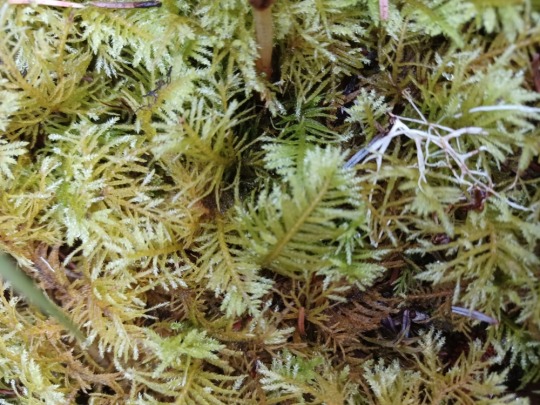
(Originally posted on my blog at https://rebeccalexa.com/the-hidden-world-of-moss-forests/)
Last week I wrote about why it’s important to preserve all sorts of ecosystems, not just forests. Today I want to discuss an ecosystem-within-an-ecosystem you may not have realized was there, and why it’s so important to preserve it: moss forests.
Recently I was listening to this episode of NPR’s Radiolab, featuring the work of Korena Mafune and Nalini Nadkarni. The show focused on the diverse and highly important ecosystems centered around moss, high up in the trees, and how even the trees themselves benefit from their mossy coverings. Many people think of moss only as something that grows on trees, rocks, and roofs, and as a nuisance which often needs to be removed from lawns and sidewalks. Yet these humble bryophytes are the foundation of their own miniature ecosystems, as important to them as trees are to larger forests.
Within the tangled green of moss forests lives a wide variety of beings. Springtails are tiny arthropods; while they have six legs, they are only related to insects and not a part of that class. Some species are carnivorous, hunting even tinier creatures like nematodes and tardigrades; others are herbivores, grazing on the moss and other small plants, while still others are omnivores. There are even detritivorous springtails, which feed on decaying matter and help release nutrients into the food web.
The springtails aren’t alone, though. They are a favorite prey of spiders that hunt in moss forests. And both aquatic and terrestrial invertebrates make their homes here. The aforementioned nematodes and tardigrades, as well as rotifers, are just some of the aquatic beings that thrive best in the rainy months when the moss holds pools and droplets of water. Drier times are better for the springtails, as well as their neighbors, the mites, along with various other insects, spiders, and other invertebrates. Like a seasonal wetland, the mosses help to preserve water even after the rains have ended, and allow the beings who live within their leaves to survive and thrive year-round.
So why care about such little living beings? Well, for one thing, they’re important parts of the food web, in which small beings are eaten by bigger ones, which themselves are then eaten by even larger ones. So a spider hunting springtails in the moss could be eaten by a small salamander, which is then caught and eaten by a garter snake, who then ends up as lunch for a great blue heron chick being fed in the nest by its diligent parents.
But they’re also important in their own existence, as are all beings. Too often we only ascribe importance to living beings that we consider to be economically valuable, or that are charismatic megafauna or flora. It’s easier for us to want to help endangered tigers or rhinoceroses, but the smaller, less flashy beings have fewer cheerleaders. And that’s a problem.

Many people, me included, have read and enjoyed Braiding Sweetgrass by Robin Wall Kimmerer. While I thoroughly enjoyed it myself, I actually like her earlier book even more! Gathering Moss: A Natural and Cultural History of Mosses is exactly what the title says: an immersion into not only what mosses are and how they support local ecology, but their importance to a wide variety of indigenous communities and traditions.
One of the things that really made my heart sink was when Kimmerer wrote about commercial moss collection. The entire chapter “The Bystander” describes in painful detail how commercial moss collectors will rip away moss forests from their tree branches, stuff them in sacks, and carry them away. Moss does not generally grow back after these “clearcuts”; it started growing on the trees shortly after they sprouted and began seeking the sun, which means the moss hunters were wholesale destroying colonies that could have been centuries old.
And they didn’t just take the moss, either. As Kimmerer describes: “…in the bag are also untold billions of beings who made that moss their home, like birds nesting in a forest. Scarlet Orbatid mites, bouncing springtails, whirling rotifers, reclusive waterbears, and their children: shall I say all their names in a requiem mass?” (p. 153)
The bags of kidnapped moss forests are then carried to buyers who trade these priceless ecosystems for a few dollars. The moss is then dried–killing anything left alive–and sold to florists who want a more “natural, wild” appearance in their arrangements, or gardeners who use it as a mulch in pots and beds. Large sheets of moss may be dried intact, dyed, and used as indoor decoration, far from the forests they came from. Dried moss is used to stuff wire-frame animals, trying to evoke the wilderness while destroying the wilderness.
Yes, there are commercial moss hunters who do things legally (though Kimmerer writes that "Illegal harvest is thought to be as much as thirty times higher than the legal quota." p. 154) Some even try to use more sustainable practices, such as taking no more than 50% of moss in a given area, or only collecting moss from rocks. But when the moss that remains grows very slowly no matter its substrate, and literally cannot grow back on the now-bare tree branches–older branches are too smooth to allow the moss to recolonize them–what good is 50% as a target? Especially when illegal poachers may come along and steal the rest? And especially when even the legal moss hunters are still killing billions of tiny invertebrates, the backbone of a forest food web, with every haul?

None of the commercial uses for moss are a matter of life and death for humans, but they certainly are for the moss forests. No one needs to have draped sheets of dried moss in their home or business, and no one needs to pretend their wood-paneled living room is a forest by placing a moss-stuffed wire deer in the corner next to some birch logs. Florists with their high environmental footprint do not need to add to their impact by fueling the demand for mosses to adorn temporary arrangements that will ultimately end up in the trash once they wilt and turn moldy. Even peat, which often contains large amounts of moss in varying states of decay, is no longer a necessary source of fuel, especially when greener energy sources are on the rise.
So what do we do from here? The easiest way to help slow the demand for moss is to simply not buy it. Avoid home decor that has moss incorporated into it, or only buy these items secondhand (which may involve haunting thrift shops, which generally offer better prices anyway!) If you absolutely must buy floral arrangements, see if you have a florist who grows their own flowers and other plants rather than importing hothouse flowers that must be flown in from thousands of miles away, and skip the moss entirely.
If you decide you want to grow a moss lawn (which is more ecologically friendly and easier to maintain than grass), either transplant small “starters” of moss from rocks and soil (not trees!) in nearby ecosystems that have large amounts (assuming it’s legal to do so), or buy from a moss supplier. In the case of the latter, I encourage you to ask where the moss comes from, how it’s harvested, what sustainability guidelines the company uses, etc. The more you know about where your moss is sourced, the better decisions you can make.
But we also need to pressure our legislators to protect moss. Most of the U.S. moss forests being stripped away are either from the Pacific Northwest or the Appalachians, and for the most part all you need is a permit to collect legally on some areas of land–or to be very sneaky if you decide to go collect where it’s prohibited and enforcement is difficult to nonexistent. Those of us in these states need to be contacting our elected officials, as well as the various natural resources entities, to urge them to end the commercial collection of mosses entirely.
And we need to educate others. Most people have no idea this is a problem! When people are empowered with knowledge, they are more likely to make conscious, informed decisions. Yes, it doesn’t work 100% of the time, but some of the time is better than none of the time. Every person who realizes what’s going on and wants to do something about it is one more voice adding to the message.
You can even start by sharing this article with others–the links throughout the text are good resources for further reading, as is Gathering Moss. And, as always, you can contact me if you need even more resources.
Did you enjoy this post? Consider taking one of my online natural history classes, checking out my other articles, or picking up a paperback or ebook I’ve written!
#long post#botany#biology#ecology#endangered species#environment#environmentalism#conservation#nature#naturecore#cottagecore#witchy#herbalism#plants#moss#forests#forest#gardening#wildlife#invertebrates
1K notes
·
View notes
Photo



Horsing Around with Horse Flies
Though horse flies are regarded worldwide as pests, members of the family Tabanidae are an important part of their natural environments. Adults feed on nectar, and some are specialized pollinators that have evolved to only collect from a few select flowers. Just like mosquitoes, only female horse flies feed on blood. Reproduction requires moisture; typically clean, stagnant or slow-moving water. Because of this, some species of horse fly are excellent indicators of an ecosystem’s health. Their role as disease carriers is also a valuable part of any functioning ecosystem; diseases can keep animal populations in check, and sick animals are often easier targets for predators. Horse flies themselves are also a juicy treat for amphibians, reptiles, and birds, as well as insects like wasps and spiders.
There are about 4,455 species of Tabanidae flies, the majority of which reside in the genus Tabanus. Most species share the same general body shape: a large head, a fat body supported by six legs, and one pair of wings. However, there are many variations on this pattern in terms of size, color, and specialized appendages. The smallest horse flies are only 5 mm (0.19 in) long, while the largest is over 30 mm (1.18 in). Like other flies, horse flies have a set of compound eyes made up of thousands of ommatidia: specialised units which allow them to combine input from multiple angles. The resulting image has a poor resolution, but it’s useful for detecting rapid movement-- an important tool when trying to avoid predators. The eyes of male horse flies are holoptic, meaning they meet in the middle to give the appearence of one continuous eye.
Horse flies go through a complete metamorphosis, also known as holometabolism, over the course of their lives. Eggs are laid of clusters of anywhere from 100 to 1000, typically on plants near a source of fresh water. After about six days, the larvae hatch and drop down into the water or burrow into the moist ground, and use a respiratory siphon to pull air from the surface. In temperate regions the grubs enter a stage of dormancy, while tropical horse flies develop year-round. While in this stage individuals consume a number of other insect larvae, worms, and aquatic insects. Once fully developed the horse fly larva pupates for one to three weeks, after which it emerges as a fully-grown adult. Mating can occur as soon as the wings have fully expanded, although female horse flies need to feed on large quantities of blood before depositing the egg mass, in order to provide her young with the nutrients they need to develop.
Conservation status: No horse fly species has been evaluated by the IUCN, and due to their large numbers populations are considered stable. However, some species only live in certain habitats, particularly wetlands, which are threatened by pollution or destruction.
If you like what I do, consider leaving a tip or buying me a ko-fi!
Photos
Large marsh horse fly (Tabanus autumnalis) by AJ Cann
Greenhead horse fly (Tabanus nigrovittatus) by Claudia Husseneder
American horse fly (Tabanus americanus) by Sturgis McKeever
#horse fly#Diptera#Tabanidae#true flies#flies#insects#arthropods#generalist fauna#wetlands#tropical forests#temperate forests#grasslands#Savannahs#deserts#urban fauna#north america#south america#europe#asia#africa#oceania#animal facts#biology#zoology
225 notes
·
View notes
Text

January 5, 2024 - White-browed Meadowlark (Leistes superciliaris)
Found in parts of Bolivia, Brazil, Chile, Paraguay, Argentina, Uruguay, and Peru, these meadowlarks inhabit grasslands and wetlands. They eat arthropods and seeds, foraging on and near the ground, often in large flocks. Usually breeding in loose colonies, they build deep cup-shaped nests on the ground from grasses and other plant materials where females lay clutches of three to five eggs. Males perform flight displays, gliding downward with their wings and tails spread while singing.
#white-browed meadowlark#meadowlark#leistes superciliaris#bird#birds#illustration#art#grassland#birblr art
66 notes
·
View notes
Text
The Middle Glaciocene: 110 million years post-establishment

Fishing for Compliments: The Fisshors
The continent of Fissor had broken off during the Therocene, and later, as of the Middle Glaciocene, had once more rejoined with the mainland, into a single massive supercontinent known as Gestaltia. But this brief isolation had been enough to allow strange forms of life to evolve in the absence of other mainland species-- one of these being the tri-lobed trunked, bipedal walkabies known as the rhinocheirids.
The rhinocheirids' bizarre anatomy and adaptable omnivorous diet would allow them to continue surviving even as the land merged and intermingled with the suoercontinent, as they simply were so unlike anything else that had evolved on the mainland that they could fill still-vacant niches that others hadn't exploited. And so the rhinocheirids proceeded to thrive in a new world: as tiny, arboreal nectar-feeders, as medium-sized terrestrial foragers, and in a few species, as wading hunters of small aquatic prey.

Most remarkable of the rhinocheirids, however, are the fisshors: a group directly descended from the Therocene's browsing snoas. While obligate vegetarian snoas since have disappeared, these much-more flexible omnivores have persisted, thanks to their dexterous trunks and more complex cognitive capacity granting them an innovation previously unseen anywhere on this planet: sophisticated tool use.
Fisshors are distinguished from other rhinocheirids by their greatly elongated lower lip, which functions almost like a second trunk-- while far less dexterous, it is well able to assist the trunk in tasks that it could not do by itself. As such, these clever creatures can fashion their own tools: breaking a branch off a tree, it can then hold the branch with its boneless, yet muscular trunk, while the lower lip snaps off smaller twigs and branches to sculpt the branch into shape, crafting a customized tool from a pre-existing item in its environment.
Many of them, primarily basal species like the four-foot tall marshland fisshor (Ramusufructuarius vulgaris) would use these tools for hunting small aquatic prey, such as shrish and freshwater skwoids, which they would lure to the surface by dropping small floating objects as bait, experimenting with leaves, flowers or even dead insects to attract prey to striking range. At first, their branch tools were used like clubs, stunning prey, but a few innovative individuals that learned to make tools with a sharper end-- a proper spear, that they used for spear-fishing. Social and intelligent in nature, these few creative geniuses were quickly imitated by their peers, and in the case of mothers with young, actively taught their children, through example, how to sharpen their spears to catch themselves food.
But other, more derived species would move away from an aquatic lifestyle to search for food on land, like the ornate probesnout (Nasodexteryx polychromis), a small omnivore, barely two feet in height, living in large groups that forage on the forest floor. They have a particular taste for insects--especially hive-making arthropods like ants, termites and social beetles. Here their proficiency with tools once again comes in handy: using stones to break open mounds and then probing the mounds with sticks to collect the insects that come swarming out. Their vivid markings are unique to each individual, and probesnouts are able to recognize friends, foes and family by sight alone-- a feature that has been favored in this small, vulnerable animal so dependent on its social groups.
Indeed, with Fissor's peninsula still few in predators, save for the armadiles that occasionally target the fisshor's young, many of these species have enjoyed a relatively tranquil life in the forests and wetlands. The same, however, cannot be said for the Gestaltian mainland, prowled by zingos, marewolves, beelzeboars and the last of the large carnohams that had made one last push into Gestaltia from their last stronghold in Borealia. The plains and scrublands are a dangerous place, with fewer trees to hide, and the grassland-dwellers, pressured to adapt, would give rise to the most specialized fisshors of all: the branchstaffer (Virgabaculus pugnator).
Their proficiency for using tools to procure food would also lead to them learning to craft branches into weaponry to defend themselves from the broad array of predators out in the plains, as, at only about four feet in height and a weight of just over 70 pounds, it is by no means by itself a threat to the various local carnivores. A preferred tool are long tree limbs, broken at lengths long enough to be wielded by both the trunk and the forelimbs as additional support, with branchstaffers notable for sporting more robust arms than other contemporary rhinocheirids. Using these blunt weapons as striking tools, they can inflict serious injuries on even large predators, and often fend them off by raising their stick in the air while making a loud, reverberating unmistakable cry --somewhere between a trumpet and a howl-- that many local predators quickly associate with a meal not worth the beating. Ever innovative, territorial males are also known to use their sticks against one another: and evenly matched, it becomes almost a round of fencing, with the loser generally being whoever's stick breaks first or is lost.
Their intelligence, social behavior and capacity for constructing objects that give them a degree of control over their environment is without a doubt a tremendous milestone for life on HP-02017 as a whole: a creature that overcomes the limitations of its own anatomy by shaping their world around them to suit their needs. Indeed, if one is to consider the intellectual capacity of animals like chimpanzees and elephants to already fit the definition, the fisshors can, arguably, already be considered having crossed the threshhold of sapience. But, very soon, another species would beat them to the intellectual race and cross the threshhold far less ambiguously: one whose first contact with this budding intelligence is not fated to end in a peaceful resolution.
▪▪▪▪▪▪▪▪▪▪▪▪
49 notes
·
View notes
Photo
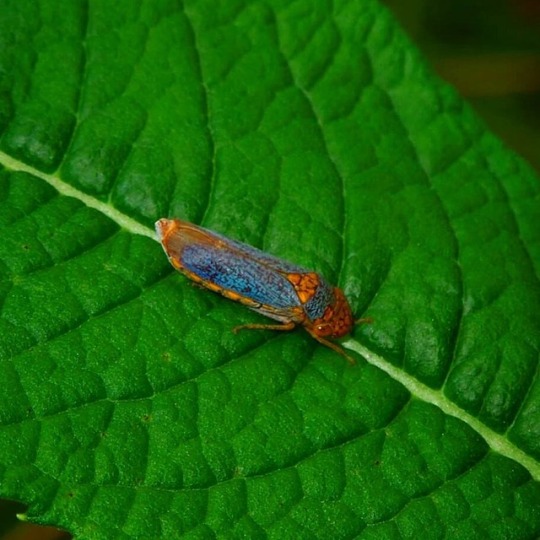
Meet the broad-headed sharpshooter (Oncometopia orbona). #leafhopper #sharpshooter #insects #insectagram #insectsofinstagram #arthropod #arthropodsanonymous #bugs #nature #natureporn #appalachia #appalachianmountains #pinkbeds #critters #thelittlethings #creatures #outdoors #hiking #hikingadventures #wetland
#creatures#insectsofinstagram#pinkbeds#critters#hiking#appalachianmountains#hikingadventures#arthropodsanonymous#wetland#nature#insects#leafhopper#outdoors#thelittlethings#bugs#insectagram#arthropod#sharpshooter#natureporn#appalachia
19 notes
·
View notes
Text
2020 Year In Review
This year once again I invited some friends and colleagues to reflect on 2020
JG Thirlwell
Composer
Foetus Xordox Manorexia Steroid Maximus Venture Bros Archer
www.foetus.org
2020 was a troubling and disturbing year.
I created a lot of music and experienced a lot of nights waking at 5am in a panic.
I deeply missed the sacred experience of being able to see live music.
In its absence of that I listened to a lot of music.
It was difficult to whittle down this list but here are a lot of albums I enjoyed in 2020, in no particular order.
Le Grand Sbam Furvent (Dur Et Doux)
John Elmquist’s HardArt Group I Own an Ion (900 Nurses)
Roly Porter Kistvaen (Subtext)
Liturgy Origin Of The Alimonies (YLYLCYN)
Clark Kiri Variations (Throttle)
Dai Kaht Dai Kaht I & II (Soleil Zeuhl)
Chromb Le livre des merveilles (Dur Et Doux)
Horse Lords The Common Task (Northern Spy)
Ecker & Meultzer Carbon (Subtext)
Insane Warrior Tendrils (RJ’s Electrical Connections)
Jeff Parker Suite For Max Brown (International Anthem)
Jacob Kirkegaard Opus Mors (Topos)
Tristan Perich Drift Multiply (Nonesuch)
Bec Plexus Sticklip (New Amsterdam)
Vak Budo (Soleil Zeuhl)
Merlin Nova BOO! (Bandcamp)
The The Muscle OST (Cineola)
Zombi 2020 (Relapse)
Regis Hidden In This Is The Light That You Miss (Downwards)
Rival Consoles Articulation (Erased Tapes)
Sarah Davachi Cantus, Descant (L.A.T.E.)
Sufjan Stevens The Ascension (Asthmatic Kitty)
Idles Ultra Mono (Partisan)
Daedelus The Bittereindeers (Brainfeeder)
Boris No (Bandcamp)
Aksak Maboul Figures / Un peu de l’ame des bandits / Onze Danses Pour Cobattre La Migraine (Crammed)
Noveller Arrow (Ba Da Bing)
Felicia Atkinson Everything Evaporate (Shelter Press)
Ital Tek Dream Boundary (Planet Mu)
Author and Punisher Beastland (Relapse)
Sparks A Steady Drip Drip Drip (BMG)
Corima Amatarasu (Soleil Zeuhl)
Code Orange Underneath (Roadrunner)
Deerhoof Future Teenage Cave Artists /Silly Symphonies / To Be Surrounded../ Love Lore(Joyful Noise)
Sote Moscels (Opal Tapes)
Run The Jewels RTJ4 (Jewel Runners)
Oranssi Pazuzu Mestarin Kynsi (Nuclear Blast)
Master Boot Record Floppy Disk Overdrive (Metal Blade)
Kaitlyn Aurelia Smith The Mosaic Of Transformation (Ghostly International) / Ears (Western Vinyl)
Michael Gordon Acquanetta (Cantelope)
Neom Arkana Temporis (Soleil Zeuhl)
Rian Treanor Ataxia / File Under UK Metaplasm (Planet Mu)
Helm Saturnalia (Alter)
Ivvvo doG (Halcyon Veil)
Robert Normandeau Figures (Empreintes Digitales)
Ben Vida Reducing The Tempo To Zero (Shelter Press)
Beatrice Dillon Workaround (Pan)
Dan Deacon Mystic Familiar (Domino)
Sea Oleena Weaving A Basket (Higher Plain Music)
Elysian Fields Transience Of Life (Ojet)
Rhapsody Symphony Of Enchanted Lands II - The Dark Secret (Magic Circle)
Duma Duma (Nyege Nyege)
Ulla Strauss Tumbling Towards a Wall / Seed (Bandcamp)
Honorable mentions
Carl Stone Stolen Car (Unseen Worlds) Nazar Guerilla (Hyperdub) Iwo Zaluski with the Children of Park Lane Primary School, Wembley The Remarkable Earth Making Machine (Trunk) Nahash Flowers Of The Revolution (SVBKVLT) Cindy Lee Whats Tonight To Eternity (Bandcamp) Insect Ark The Vanishing (Profound Lore) 33EMYBW Arthropods (SVBKVLT) Declan McKenna Zeroes (Tomplicated) Layma Azur Zeii (Bandcamp)
FILM TV
Succession
ZeroZeroZero
Escape at Dannemora
1917
Small Axe : Five films by Steve McQueen
Pirhanas
Monos
The Hater
Better Call Saul
+++++++++++++++++++++++++++++++++
Drew Daniel
Matmos, The Soft Pink Truth
an alphabet of 2020 recordings
Arca “KiCk i”
BFTT “Intrusive / Obtrusive”
clipping. “Visions of Bodies Being Burned”
Duma “Duma”
Eilbacher, Max “Metabolist Meter (Foster, Cottin, Caetani and a Fly)”
Forbidden Colors “La Yeguada”
GILA “Energy Demonstration”
HiedraH Club de Baile “Bichote-K Bailable Vol. 2”
Ian Power “Maintenance Hums”
Jeff Carey “Index[off]”
Kassel Jaeger “Meith”
Laurie Anderson “Songs From the Bardo”
Mukqs “Water Levels”
Negativland “The World Will Decide”
O’Rourke, Jim “Shutting Down Here”
Perlesvaus “These Things Below with Those Above”
Quicksails “Blue Rise”
Rian Treanor “File Under UK Metaplasm”
Slikback “///”
Terminal Nation “Holocene Extinction”
Ulcerate “Stare Into Death and Be Still”
Various Artists “HAUS of ALTR”
William Tyler “New Vanitas”
Xyla “Ways”
Y A S H A “Summations”
:zoviet-france: “Châsse 2ᵉ”
+++++++++++++++++++++++++++++++++
Sarah Lipstate (Noveller)
With all live performances canceled, this was truly the year of demo videos and home studio recording for me. These are 10 pieces of gear that came out in 2020 that helped keep me feeling creative and inspired during lockdown. In no particular order:
EHX Oceans 12 Dual Stereo Reverb - The Oceans 12 ticks all the boxes for what I’m looking for in a great soundscaping reverb. I used the Shimmer and Reverse algorithms in conjunction a lot when I was composing music for a film score.
Chase Bliss Audio Blooper - While I don’t actually own a Blooper, I had the pleasure of borrowing one from Mike of Baranik Guitars after NAMM this year. He made an incredible Blooper-inspired guitar and I was completely charmed by them both. Chase Bliss always delivers pedals that push me creatively and the Blooper truly hits the mark.
Cooper FX Arcades - I love everything Cooper FX has released to-date so the opportunity to access those sounds in one pedal via plug-in cartridges is just awesome.
SolidGoldFX NU-33 - I was asked to do a demo of this pedal for its release and ended up being really charmed by this box’s approach to lo-fi nostalgia. I’ve used it a lot for film scoring and highly recommend adding it to your collection.
Demedash Effects T-120 DLX V2 - I LOVE a good tape echo and the T-120 Deluxe V2 ranks up there with the best I’ve tried. This pedal made its way to me this Christmas and I look forward to making some beautiful sounds with it in the new year.
Hologram Electronics Microcosm - The Microcosm is one of those pedals where you should fully read the manual before diving in but once you put in that initial effort you’ve got a massively powerful tool on your hands. It does glitch like no other. Definitely worth the homework
Azzam Bells MP019 - I discovered this unique instrument through a post on Reverb’s IG page and immediately looked it up and ordered one. These experimental percussion instruments are hand-made in Italy and they’re as beautiful visually as they are sonically. I used it for bowed cymbal and daxophone sounds on a film score and it was absolutely haunting.
Echopark Dual Harmonic Boost 2 - I love the control you have over dialing in the perfect amount of grit with these dual boost circuits. I use it a lot as a textural tool when I’m laying down drones or bringing in big distorted swells. It’s one of the most versatile overdrives in my collection and I love that.
Fender Parallel Universe Series Volume II Maverick Dorado - I was smitten with the Maverick Dorado when I first saw it at NAMM. It has a lot of the specs that I look for in a guitar and the body shape with the Mystic Pine finish just blew me away. I hope that I get to use it live soon.
Polyeffects Beebo - The Beebo is one of those pedals that I genuinely feel is smarter than I am. It’s like an entire computer in one small touchscreen box. I can’t claim to have mastered using it yet but the sounds that I have managed to get out of it so far have been brilliant. I’m looking forward to spending more time with this box in 2021
+++++++++++++++++++++++++++++++++
HELM 2020 REVIEW
Let's get the bad stuff out the way first, 2020 was undoubtedly an awful year. I'm still not sure how to really respond to seeing a global pandemic bring the capital to its knees and everything I love and hold dear to a grinding halt. Our government fucked it's response, putting profit before people and killing tens of thousands. The Labour Party descended into farce with the newly elected leader Sir Keith revealing himself as a bland centrist with no opposition or ideas. On a personal level it sucked not being able to travel or see my friends in different parts of the world - or even the same country - who I am starting to miss a lot. However, I was fortunate enough to get through the year with my sanity intact. Music, art and culture once again being my main positive. I think I listened to more music than I have in any year ever. I read more books than I have done since I was a teenager probably. I also re-discovered the joys of walking long distances and am extremely thankful for living near a lot of incredible green spaces: Epping Forest, Walthamstow Wetlands, Walthamstow Marshes, Wanstead Park, Wanstead Flats...
Music. My favourite albums of the year.
Oranssi Pazuzu - Mestarin kynsi
Wetware - Flail
Raspberry Bulbs - Before The Age Of Mirrors
Necrot - Mortal
Rope Sect - The Great Flood
Private World - Aleph
Oneohtrix Point Never - Magic Oneohtrix Point Never
Pyrrhon - Abcess Time
CS+Kreme - Snoopy
Speaker Music - Black Nationalist Sonic Weaponry
Drew McDowall - Agalma
Regis - Hidden In This Is The Light That You Miss
Nazar - Guerilla
Zoviet France - Russian Heterodoxical Songs (and all the ZF reissues!!)
Triple Negative - God Bless the Death Drive
Permission - Organised People Suffer
Actress - Karma & Desire
Acolytes - Stress II
The Gerogerigegege - >(decrescendo)
Chubby & The Gang - Speed Kills
Flora Yin-Wong - Holy Palm
Eiko Ishibashi - Hyakki Yagyo
The The - See Without Being Seen
Prurient - Casablanca Flamethrower
Henning Christiansen - L’essere Umano Errabando La Voce Errabando
Subdued - Over The Hills And Far Away
Rian Treanor - File Under UK Metaplasm
Komare - The Sense Of Hearing
Shredded Nerve - Acts Of Betrayal
Jesu - Terminus
Autechre - SIGN
Hey Colossus - Dances / Curses
Sparkle Division - To Feel Embraced
Mark Harwood - A Perfect Punctual Paradise Under My Own Name
Still House Plants - Fast Edit
The Bug & Dis Fig - In Blue
Kommand - Terrorscape
Haus Arafna - Asche
Khthoniik Cerviiks - Æequiizoiikum
Worm - Gloomlord
Kraus - A Golden Brain
Faceless Burial - Speciation
A shout-out to Jon Abby's AMPLIFY series on Bandcamp / Facebook, which I contributed a new piece of music to.
A shout out to the labels where most of the music I listened to seemed to come from:
The Trilogy Tapes
Iron Bonehead
Penultimate Press
Dais
La Vida Es Un Mus
Gigs. Despite live music being destroyed in 2020 I still saw a few unforgettable performances at the beginning of the year.
Graham Lambkin @ The ICA, London
Puce Mary / JFK @ The Glove That Fits, London
Demilich @ Finnfest, The Garage, London
Container / PC World / National Unrest @ Venue MOT, London
S.H.I.T / Asid / Chubby & The Gang @ Static Shock Festival, ExFed, London
Books I enjoyed. Most not published this year, but all read in 2020.
Joe Kennedy - Authentocrats
David Balzer - Curationism
Tom Mills - BBC: The Myth Of A Public Service
Simon Morris - Consumer Guide: Special Edition
Luke Turner - Out Of The Woods
Various - Bad News For Labour
Mike Wendling - Alt-Right
Baited Area issues 1 & 2.
Film. Three good films I saw this year which I hadn't before.
Suspiria (Remake)
Midsommar
Cannibal Holocaust
Podcasts. I listened to a lot of these whilst walking.
We Don't Talk About The Weather
Novara Media Tysky Sour & Novara FM
Grounded with Louis Theroux
System of Systems
Red Scare loveline episodes
Suite 212
NOISEXTRA
Social Discipline
CONTAIN
TV.
Didn't watch a huge amount and what I did was mostly trash. For some reason I rewatched both series' of This Life, a British drama from the late 90's about a group of young professionals house sharing and navigating their careers. Very cringey and has aged terribly, but it was perversely fascinating to revisit something from that time in the age of the pandemic. Following on from this I binge watched the entire series of Industry which was entertaining enough. A programme about a bunch of horny bankers with what felt like a confused ideology behind it. It seemed stuck between trying to criticise and glorify the culture around the industry, but also protect the industry itself from outside criticism by portraying anyone who may oppose as an insufferable wanker. Currently halfway through Succession which is OK. The Murdoch documentaries on the BBC were excellent and a rare respite from their descent into client journalism.
Thanks to anyone who listened to my music this year also. Best wishes to you all for 2021.
Luke Younger
http://hhelmm.com | http://alter.bandcamp.com
+++++++++++++++++++++++++++++++++
Elliott Sharp
composer
1. My Nr. 1 lesson: patience. Whether it's bouncing through 30 seconds of severe turbulence at 39000 feet or slogging through 30 minutes of a interminable piece of concert music, one attribute I've tried to develop is the ability to see past the discrete and awaited ending, the exact framing of the immediate process, but put it into the context of a larger time frame. I've found that this year more than all others has demanded it. Breathing helps...
2. Books: revisiting old favorites from the realm of Thomas Pynchon and Philip K. Dick (both especially relevant), digging into John Lomax's portrait of Jelly Roll Morton, the works of Colson Whitehead, random things off of the shelf…
3. Composing: with touring off the table, I focused on that which needed to be written, some requested and commissioned, some spontaneously springing forth. Composing requires that one open the windows wide to the world, which at this moment brought in grief, terror, uncertainty, anxiety, visions of plague and pestilence and incipient fascism. Okay, now shut the window and get to work! How to process, translate, transform? The work can be a comfortable and obsessive cocoon once one learns to handle the radioactive materials and put them into the creativity reactor.
4. Beans! We have long been a fan in our house of the wide world of legumes but this year brought two stars to the front: the black bean and the red lentil. The black bean commands the lofty peaks but the seemingly infinite variations of dal surround it. Ginger, garlic, turmeric, smoked paprika, cayenne, onions, and olive oil form the basis then imagination builds.
5. Online teaching substituted for my canceled conduction of workshops in the Pyrenees Mountains of France. Between the participants and myself, we built a temporary but very congenial space online to share concepts and music. In addition, private lessons brought conversation and music with new friends in Germany, Italy, California, Australia, Illinois, Denmark, Pennsylvania, Spain, Florida, Brazil.
6. What started out as "stress baking" (before I even had heard of the term) soon became a frequent practice that yielded very edible results. The twins preferred the sweeter forays into banana bread and chocolate cake. I tried to find a balance between tried-and-true techniques and experiments in texture and taste with yeasted pumpernickels, multi-grains, and seed breads.
7. While not the same as performing 'live ', online gigs proved that it was possible to generate a surprising amount of adrenaline even without the pheromonal handshaking of a room filled with receptive ears. As a corollary, online recording collaborations with friends worldwide proved to be inspiring and a suitable substrate for sonic experimentation, exploration of new instruments, tunings, effects programming, structures. In these realms, shout-outs to Helene Breschand, Mike Cooper, Henry Kaiser, Tracie Morris, Mikel Banks, Dougie Bowne, Payton McDonald, Billy Martin, Colin Stetson, Jim O'Rourke, Scott Amendola, Roberto Zorzi, Jason Hoopes, Eric Mingus, Melanie Dyer, Dave Hofstra, Don McKenzie, Sergio Sorrentino, Veniero Rizzardi, Taylor Ho Bynum, Scott Fields, Bachir Attar, Karl Bruckmaier, Robbie Lee, Matthew Evan Taylor, Matteo Liberatore, Al Kaatz, David Barratt, Jessica Hallock, Kolin Zeinikov, Robbie Lee, Jeremy Nesse, James Ilgenfritz, Sergio Armaroli, Steve Piccolo, Sandy Ewen, David Weinstein, Jim Whittemore, Chris Vine, Werner Puntigam, William Schimmel.
+++++++++++++++++++++++++++++++++
Daniel O’Sullivan
(Grumbling Fur, Guapo, Miasma & the Carousel of Headless Horses, Ulver, Sunn O))), Æthenor, Laniakea, Miracle, Mothlite, and This Is Not This Heat.)
Music
Richard Youngs - Ein Klein Nein
Alabaster DePlume - Instrumentals
Hildegard von Bingen - O Nobilissima Viriditas
Francisco de Penalosa - Missa Ave Maria Peregrina
Carlo Gesualdo - Responsoria 1611
Dirty Projectors - Five EPs
Sonic Boom - All Things Being Equal
Brother Peter Broderick - Blackberry
Richard Horowitz - Eros Of Arabia
Duncan Trussell Family Hour
Cocteau Twins in the bath
Books/comics
Alexander Tucker - Entity Reunion II
Derek Jarman - Chroma
Stephen Harrod Buhner - Plant Intelligence and the Imaginal Realm
The Penguin Book Of Irish Poetry - edited by Patrick Crotty
The Gospel Of Ramakrishna - translated by Swami Nikhilananda
Lucretius - De Rerum Natura
Plotinus - Enneads
Ram Dass - Grist For The Mill
Lisa Brown - Phantom Twin
Other
Fasting / meditation / macrodosing
Walks in freshly coppiced woodland (for the smell mainly).
Plants / Foraging / Growing
Traditional ferments
Douglas Sirk movies
Mandolorian
Writing songs on the piano
Rediscovery of Kenneth Graham via my kids
+++++++++++++++++++++++++++++++++
Karl O’Connor (Regis)
01.Wolfgang Press - Unremembered, Remembered
02. Klara Lewis - Ingrid Live at Fylkingen
03. Jesu - Terminus
04. Dave Ball - Leeds Poly Demos 1979
05. Edwin Pouncey - Rated Sav X (the Savage Pencil Skratchbook)
06. The Bug - In Blue
07. New Order - Power,Corruption and Lies ( Writing Sessions )
08. JG Thirlwell and Simon Steensland - Oscillospira
09. FM Einheit and Andreas Ammer - Hammerschlag
10. Thurston Moore - By The Fire
11. Body Stuff - Body Stuff 3
12. Ann M Hogan - Honeysuckle Burials
13. Rob Halford - Confess (Autobiography)
++++++++++++++++++++++++++++++++
Caleb Braaten (Sacred Bones Records)
Shirley Collins Hearts Ease
Dehd Flowers Of Devotion
Duma Duma
Bob Dylan Rough and Rowdy Ways
Green-House Six Songs for Invisible Gardens
John Jeffery Passage
Drew McDowall Agalma
Sweeping Promises Hunger For a Way Out
Colter Wall Western Swing & Waltzes and Other Punchy Songs
Woods Strange to Explain
My Favorite 90’s Nostalgia Movie Rewatches
Colors
Ghost Dog
Menace II Society
The Player
Rounders
Safe
Starship Troopers
Trees Lounge
Vampires
Waiting For Guffman
Most Culturally Bankrupt Year : 1997
+++++++++++++++++++++++++++++++++
Charlie Looker
(composer, Psalm Zero, Extra Life, Seaven Teares)
Ten Things That Didn’t Happen in 2020
1. I didn’t write a ton of new music. Don’t get me wrong, I wrote some. I always do. But mostly I focused on my new YouTube channel, essays, and on getting old recordings released. I haven’t even been working a day-job so I thought I was going to write my next Ring Cycle, but I really didn’t find Covid inspiring.
2. Trump wasn’t re-elected. Cool.
3. I didn’t lose anyone to Covid. I am, of course, profoundly grateful for this. But I feel pretty embarrassed remembering group-texting ten friends in March, “We are all going to see a loved one die. Every single one of us. Don’t kid yourselves”. I can get hysterical, and that was somewhat irresponsible of me.
4. No revolution happened. I don’t mean to be smug or cynical, or to belittle anyone’s participation in the protests. But, as far as I can tell, nothing happened in 2020 that promises to reduce police brutality or human suffering of any kind. We’ll see. That burning Minneapolis police station was exciting to watch at the time, if only on an aesthetic level.
5. I have a stack of unread books I bought this year, just staring at me, with nary a crease among them. These include:
Adorno and Horkheimer, The Dialectic of Enlightenment (looks amazing, but I haven’t touched it)
Marx, Grundrisse (it’s 1000 pages for fuck’s sake. Amazon also accidentally sent me two copies, and its double presence in the stack is just comical)
Reza Negarestani, Intelligence and Spirit (the first 15 pages blew my mind, then my mind blew it off)
6. I didn’t settle into living in LA. I moved here six months before Covid and I was just starting to cultivate some friendships and play shows. This was quashed and I still feel like I still live in New York. I still barely know the layout of the city here.
7. No brand-new buzzy musical artists burst onto the scene, that I can recall. No new hyped micro-genre of the moment. There was just no way for there to be a hot new trend. I’d say that was refreshing, but it wasn’t.
8. Tyson’s return was not awesome. Two minute rounds, ended in a draw. I’ve been getting way into boxing this past year. This fight was a bummer. I’m looking forward to Mayweather vs Logan Paul (LOL) because we know it’s comedy ahead of time.
9. For three weeks in July, I didn’t do a single thing other than watch street fight compilations on YouTube and Worldstar. That’s just grim.
10. There were no school shootings in March. Apparently, this was the first March with no school shootings since 2002. Not a single 7th grader got a hand job in March either. I cannot begin to imagine what it’s like to be a kid now.
+++++++++++++++++++++++++++++++++
Chuck Bettis
https://chuckbettis.com
Other People's Music released this year:
Coil "Musick to Play in the Dark" (Dais)
Duma "s/t" (Nyege Nyege Tapes)
Twig Harper "External Boundless Prison/ in 4 parts EP" (self-release)
I.P.Y. (Ikue Mori, Phew, YoshimiO) "I.P.Y." (Tzadik)
Kill Alters "A2B2 Live Stream 11/13/2020" (self-release)
Krallice "Mass Cathexis" (self-release)
Lust$ickPuppy "Cosmic Brownie" (self-release)
Doug McKechnie "San Francisco Moog: 1968-72" (VG+ Records)
Merlin Nova "Boo!" (self-release)
Omrb "Milandthriust, The Graths of Mersh" (self-release)
Akio Suzuki & Aki Onda "gi n ga" (self-release)
Yoth Iria "Under His Sway" (Repulsive Echo)
Wetware "Flail" (Dais)
My own music released this year:
collaborations
Chatter Blip "Microcosmopolitan" (Contour Editions)
Matmos "The Consuming Flame: Open Exercises in Group Form" (Thrill Jockey)
Reverse Bullets "Dreampop Dsyphoria" (self-release)
Snake Union "live at Roulette" (self-release)
Snake Union w/ Hisham Bharoocha, Bonnie Jones, Heejin Jang, Matthew Regula "Three Arrows" (Rat Route)
Thomas Dimuzio "Balance" (Gench Music)
YoshimiO & Chuck Bettis "Live at the Stone" (Living Myth)
solo
Chuck Bettis "Arc of Enlghtenment" (Living Myth)
Chuck Bettis "Motion Parallax" (Living Myth)
compilation
Various Artist "Polished Turds Vol.1" (Granpa)
Music Books read this year
"Intermediary Spaces" by Eliane Radigue/Julia Eckhardt (Umland)
"Ennio Morricone In His Own Words" by Ennio Morricone/Alessandro De Rosa (Oxford University Press)
"Free Jazz In Japan: A Personal History" by Soejima Teruto (Public Bath Press)
"Rumors of Noizu: Hijokaidan and the Road to 2nd Damascus" by Kato David Hopkins (Public Bath Press)
+++++++++++++++++++++++++++++++++
Maya Hardinge
(musician / artist)
list of things i liked this year
first ever solo road trip through new mexico and Texas right before lockdown
experiencing manhattan with no cars on the road . having a car to escape in to nature. (which i craved so much)
walks and bike rides with friends… FRIENDS!
The web site ‘workaway’ that helped me feel that there were options for escape.
playing games weekly on zoom during lock down
teaching yoga weekly on zoom.
Witnessing and being part of the BLM protests.
witnessing and being part of the demise of T
sitting on my couch at 6am drinking a cup of tea, appreciating my apt.
making time to meditate.
halloween without tourists .
some music I’ve bought and/or enjoyed this year
Elvis Perkins-Black Coat Daughter
Patricia Kokett -Soi soi
Henning Christiansen - OP201
Bryce Hackford- Safe
Svitlana Nianio and Oleksander - Snayesh yak? rozkazhy
Brannten schnure - Sommer im Pfirsichhain
Killing Joke - Nighttime
David Shea - Tower of mirrors
Shakey - Shakey
Woodford halse tapes
Coil - Musick to play in the dark
+++++++++++++++++++++++++++++++++
BJ Nilsen
sound artist / composer
Work 2020
Despite Covid 19 lots of things actually did happen.
In Feburary I visited the only active nuclear plant in The Nederlands as part of my "Expanded Field Recording” project together with SML. In March revisited the Acousmonium at the Elevate Festival in Graz with an additional trip deep inside the Schlossberg recording old mining trains. In March and April I did two daily recording projects “Pending and Auditory Scenes” - both of Amsterdam during lockdown. In May did my first Zoom field recording workshop with the CAMP project. In June & July two research trips in Waldviertel, Austria with Franz Pomassl. In August recorded bells and organs in 10 different churches around Amsterdam for Jacob Lekkerkerker. In September recorded Kali Malone at the Orgelpark in Amsterdam. Performed at Heart of Noise Festival in Innsbruck and A4 in Bratislava. Also went ice-skating for first time in 20? Years. In November and December I travelled to Jeju island to record field recordings for a project by Femke Herregraven for the Gwangju Biennale, commissioned for 2021.
Did lots of gardening, released two tapes “Call it Philips, Eindoven” and “Zomer 2020” with Sigtryggur Berg Sigmarsson.
NOW! Looking forward to 2021.
http://bjnilsen.info
https://soundcloud.com/bjnilsen/sets/auditory-scenes-amsterdam
+++++++++++++++++++++++++++++++++
Vicki Bennett
(People Like Us)
Negativland - True False https://negativland.com/products/truefalse-cd (this came out last year but is so THIS year)
Bob Dylan - Rough and Rowdy Ways https://www.bobdylan.com/albums/rough-and-rowdy-ways/
The Soft Pink Truth - We from Shall We Go On Sinning So That Grace May Increase https://thesoftpinktruth.bandcamp.com/album/shall-we-go-on-sinning-so-that-grace-may-increase
Carl Stone - Stolen Car https://unseenworlds.bandcamp.com/album/stolen-car
Porest - Sedimental Gurney https://porest.bandcamp.com/album/sedimental-gurney
Matmos - The Consuming Flame: Open Exercises in Group Form https://matmos.bandcamp.com/album/the-consuming-flame-open-exercises-in-group-form
Domenique Dumont - Miniatures De Auto Rhythm https://antinoterecordings.bandcamp.com/album/atn044-domenique-dumont-miniatures-de-auto-rhythm
The The - See Without Being Seen https://www.thethe.com/product/see-without-being-seen-cd/
Ciggy de la Noche - Hold Tight HMRC https://soundcloud.com/ciggydelanoche/hold-tight-hmrc
Neil Cicierega - Mouth Dreams http://www.neilcic.com/mouthdreams/
and my details:
http://peoplelikeus.org/
https://peoplelikeus-vickibennett.bandcamp.com/
pic: http://peoplelikeus.org/wp-content/uploads/2019/12/Welcome-Abroad-promo3-2-scaled.jpg
+++++++++++++++++++++++++++++++++
DJ Food
Music -
Type 303 - Sticky Disco / Analogue Acidbath 7" (45 Live)
The British Space Group - The Ley of the Land CD (Wyrd Britain)
Squarepusher - Be Up A Hello LP / Warp 10 NTS mix (Warp)
dgoHn - Undesignated Proximate (Modern Love)
LF58 - Alterazione LP (Astral Industries)
Robert Fripp - Music For Quiet Moments series (DGM)
Run The Jewels - RTJ4 (BMG)
Simf Onyx - Magenta Skyline / The Unresolved 7" (Delights)
Luke Vibert - Modern Rave LP (Hypercolour)
JG Thirlwell & Simon Steensland - Oscillospira (Ipecac)
Aural Design - Looking & Seeing 7" / DL (Russian Library)
Luke Vibert - Rave Hop (Hypercolour)
Clipping. with Christopher Fleeger - Double Live (Sub Pop)
APAT - Terry Riley's 'In C' performed on Modular Synthesizer (YouTube)
Field Lines Cartographer - The Spectral Isle LP (Castles In Space)
Jane Weaver - The Revolution of Super Visions single (Fire Records)
King Gizzard & The Lizard Wizard - K.G. LP (Flightless)
Humanoid - Hed-Set - forthcoming on (De:tuned)
Film / TV -
Inside No.9 (BBC)
What We Do In The Shadows Season 2 (Netflix)
Tales From The Loop (Amazon)
Keith Haring - Street Art Boy (BBC)
John Was Trying To Contact Aliens (Netflix)
The Social Dilemma (Netflix)
The Mandalorian (Season 2) (Disney+)
Long Hot Summers - The Style Council documentary (Sky Arts)
Zappa (Alex Winter)
Books / Comics / Magazines
Confessions of a Bookseller - Shaun Bythell (Profile books)
The Often Wrong - Farel Dalrymple (Image Comics)
Edwin Pouncey - Rated SavX (Strange Attractor Press)
Jeffrey Lewis - Fuff (all issues - really late to the party on this one)
Rian Hughes - XX - A Novel, Graphic (Picador)
Cosey Fanni Tutti - Art, Sex, Music (Faber)
Caza - Kris Kool (Passenger Press)
Dan Lish - Egostrip Vol.1
Electronic Sound magazine
Decorum - Jonathan Hickman & Mike Huddleston (Image)
John Higgs - Stranger Than We Can Imagine
Simon Halfon - Cover To Cover (Nemperor)
Very few exhibitions or shows this year for obvious reasons
+++++++++++++++++++++++++++++++++
#JG Thirlwell#playlist#Drew Daniel#Matmos#the soft pink truth#Sarah Lipstate#noveller#helm#Daniel O’Sullivan#Guapo#Miasma & the Carousel of Headless Horses#This Is Not This Heat#Karl O’Connor#regis#Sacred Bones Records#Caleb Braaten#Charlie Looker#psalm zero#extra life#Chuck Bettis#snake union#Maya Hardinge#BJ Nilsen#Vicki Bennett#people like us#DJ Food#Elliott Sharp
33 notes
·
View notes
Text
Animal Crossing Fish - Explained #112
Brought to you by a marine biologist who says it’s time for crab...
CLICK HERE FOR THE AC FISH EXPLAINED MASTERPOST!
I did it again, guys. I missed doing an animal when it was actually available, and that’s on me. To make up for it, whether y’all want to or not, it’s time for crab. For the rest of the week, we will be covering crabs because for some reason, there are so many available starting in the fall and continue into winter. SO, without further adieu, let’s start with the Mitten Crab who went away at the end of November. (It’s also about time we did a freshwater friend).

Since we will be talking crabs for the next few days, it’d be helpful to brush up on what exactly crabs are. Crabs are part of Phylum Arthropoda, all of the animals with exoskeletons and jointed legs. Arthropods are the most numerous and diverse group of animals on Earth, and include everything from insects, to spiders, to Crustaceans, for which crabs are a part. Crustacea is also a HUGE Subphylum that includes familiar animals like crabs and shrimp to things you wouldn’t believe are related, like barnacles. Most all of the recognizable Crustaceans, like crabs, are in Class Malacostraca; in fact, all of ACNH’s crustaceans besides the barnacle hail from this Class. From there, crabs fall under the Order Decapoda, those Crustaceans with ten legs (Deca- = 10; -poda = foot). The infraorder Brachyura contain the true crabs, and I gotta tell ya, one of the crabs this week is a goddamn imposter. Not the mitten crab, though. This is the Chinese Mitten Crab (Eriocheir sinensis), a true crab boi.
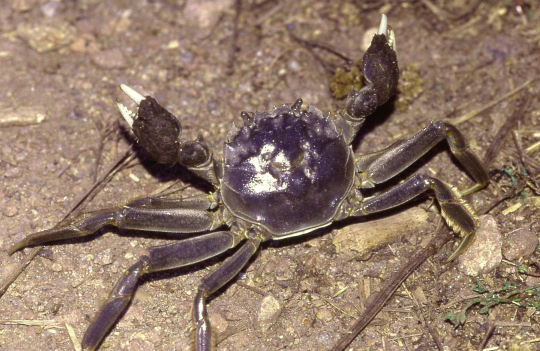
By Christian Fischer, CC BY-SA 3.0, https://commons.wikimedia.org/w/index.php?curid=342346
It’s also called the Shanghai hairy crab because of its fuzzy claws. The hair-like stuff that grows on their claws is called setae. They’re native to China, as is obvious from their other common name, as well as Korea. In both places, mitten crabs are eaten as part of Shanghai and Eastern Chinese cuisine. However, they can survive in very polluted areas where they take up heavy metals like mercury, so fishing for them needs to be regulated to keep people safe.
Nevertheless, they are considered an autumn delicacy, which may explain why they are only available during autumn on your island. In real life, mitten crabs live their lives in rivers and go into the brackish water of estuaries (where sea and river meet, often in wetlands and naturally protected bays) or the sea, to breed. That usually happens in the autumn as well, so it’s my thought that the mitten crabs on your island are breeding adults making their way to your river mouths. It’s difficult to say where your island rivers stop being inter-tidal, so I love how ACNH puts the Mitten Crab in the estuary section of the flowing river tank in the museum with our other estuarine friends, like the sturgeon and horseshoe crab!
And there you have it! Fascinating stuff, no?
#mitten crab#crab#marine biology#animal crossing#animal crossing new horizons#science in video games#animal crossing fish explained
18 notes
·
View notes